Proven Tactics for Omnichannel Customer Engagement Success
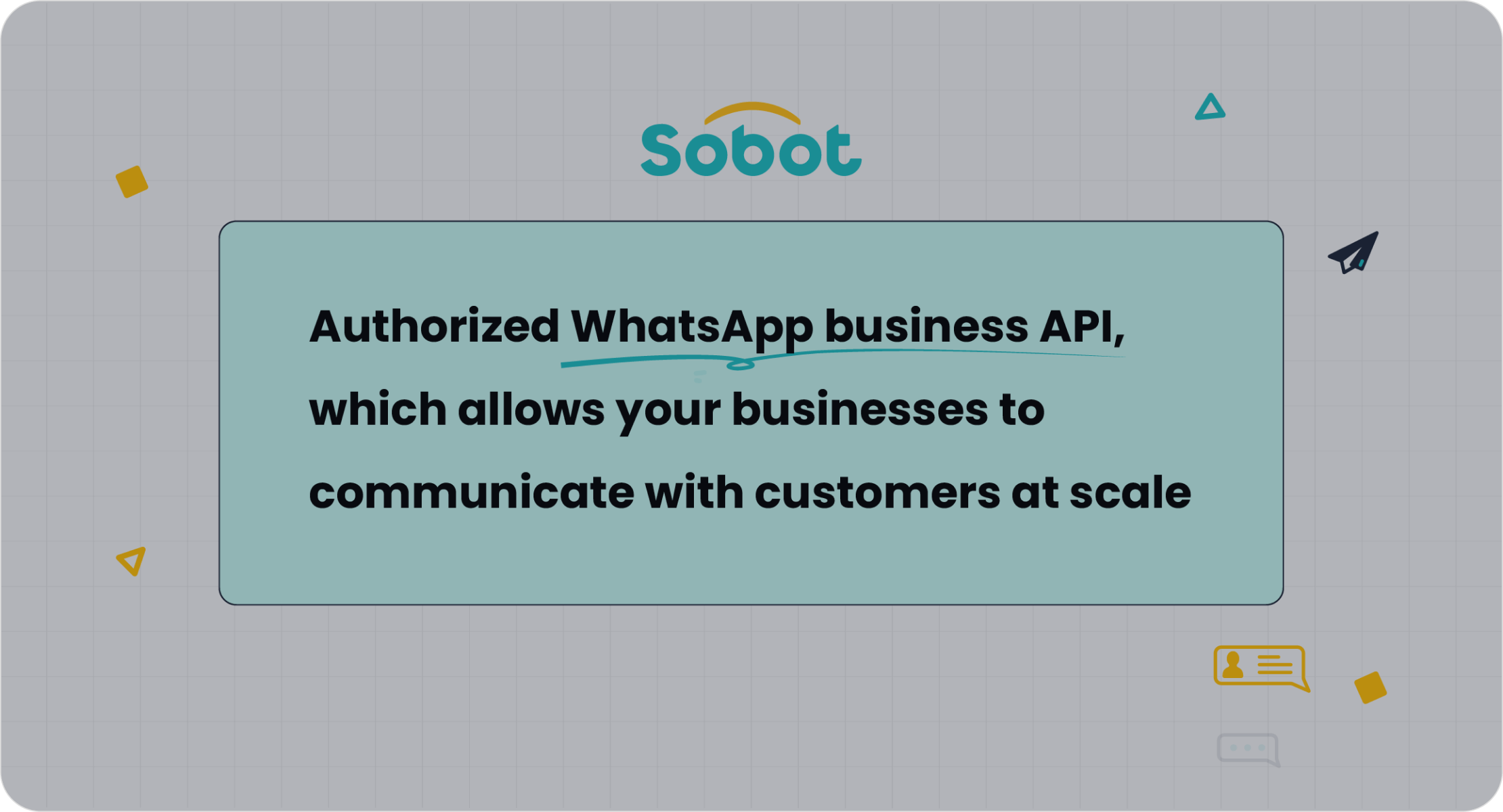
Companies that deliver a seamless experience across channels see stronger results. Businesses using omnichannel strategies report a 9.5% yearly revenue increase, compared to just 3.4% for others. Customers value quick responses and unified service, with 88% rating company experience as important as products. Sobot AI empowers brands with advanced omnichannel contact center solutions, making every customer interaction smooth and consistent. The impact is clear in the data below:
| Statistic Description | Data Point |
|---|---|
| Customers expecting consistency across all online channels | 71% |
| Omnichannel marketing campaigns purchase rate increase | 287% higher than single-channel campaigns |
| Customers valuing company experience as much as products | 88% |
| Customers using multiple channels during online shopping | 73% |
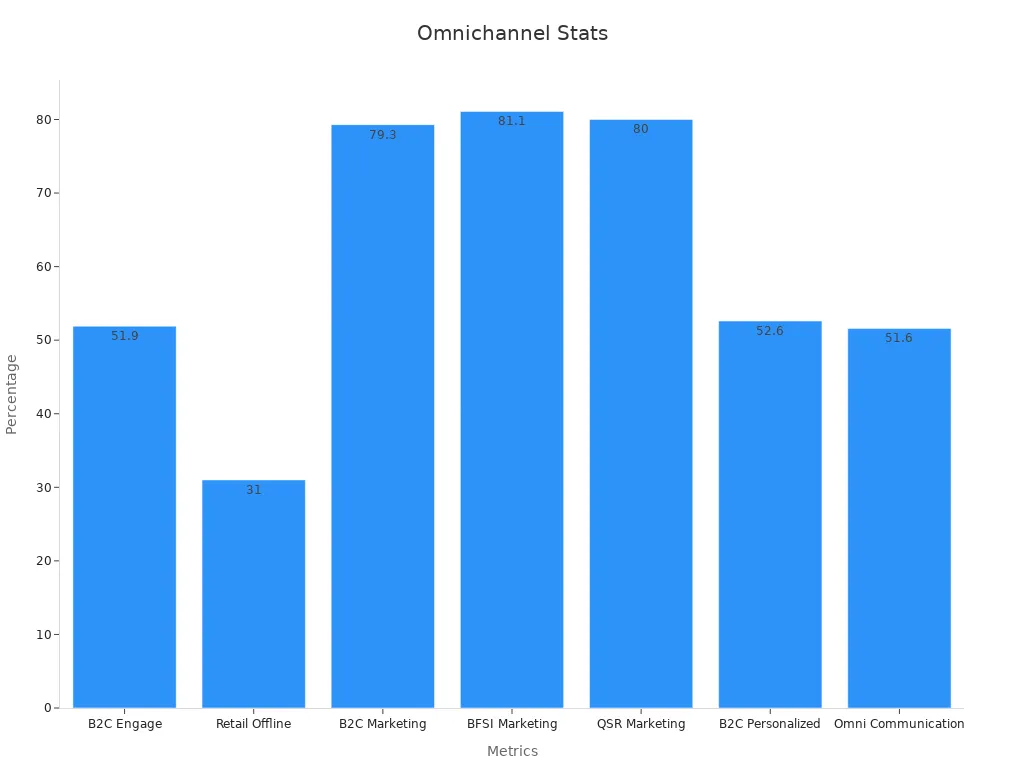
Omnichannel Customer Engagement
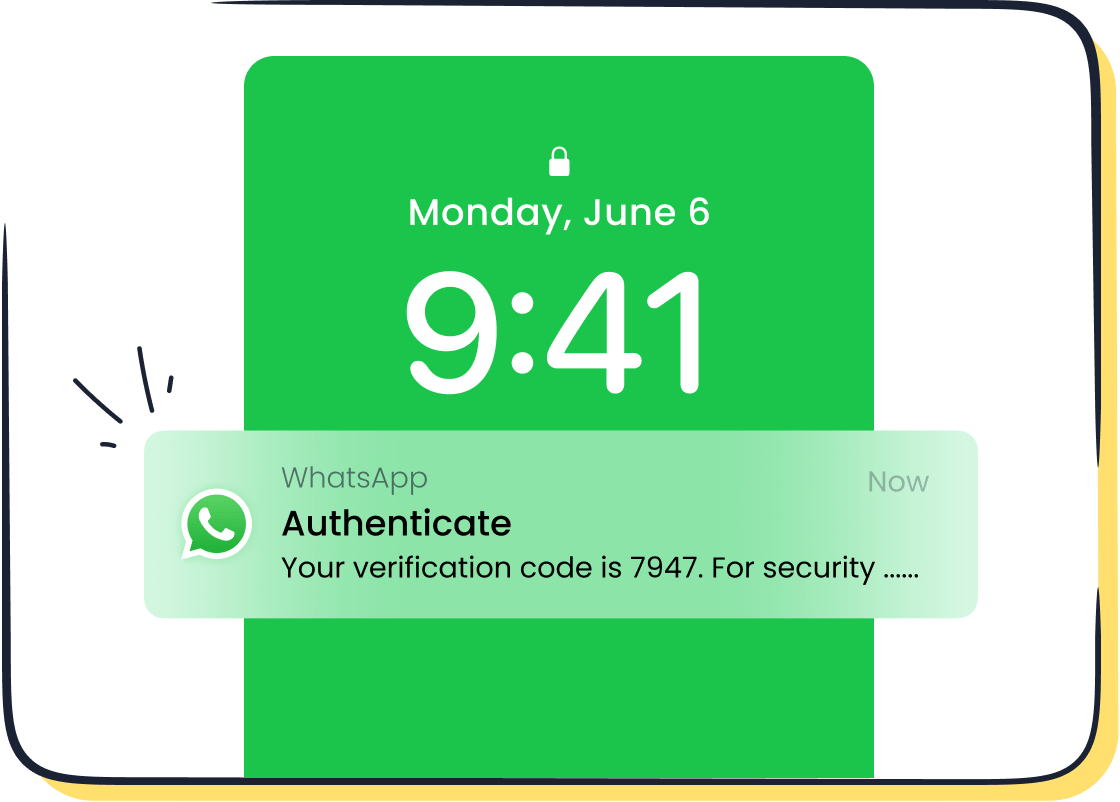
What Is Omnichannel?
Omnichannel customer engagement connects every touchpoint a brand has with its customers. This approach unifies communication across channels such as email, social media, live chat, and phone. Customers can start a conversation on one channel and continue it on another without repeating themselves. Companies like Sobot make this possible by integrating all interactions into a single platform. This seamless journey ensures that every customer receives a consistent and personalized experience, no matter how they choose to interact.
Key characteristics of omnichannel customer engagement include:
- A unified customer view that tracks all interactions in real time.
- Seamless integration across multiple channels, allowing customers to switch platforms without losing context.
- Personalized service based on customer history and preferences.
- Real-time data analytics to support strategy and improve service.
- Continuity of service, which avoids repetitive or isolated interactions.
Sobot’s omnichannel marketing solutions help businesses deliver this level of service. By using a unified workspace, agents can access customer data and respond quickly, improving both satisfaction and loyalty.
Key Benefits
Omnichannel customer engagement delivers measurable results for businesses. Companies that use strong omnichannel marketing strategies see higher retention and engagement rates. The following table highlights key metrics that show the impact:
| Metric Description | Numerical Data |
|---|---|
| Customer retention rate with strong omnichannel | 89% |
| Customer retention rate with weak omnichannel | 33% |
| Engagement rate for campaigns using 3+ channels | 18.96% |
| Engagement rate for single-channel campaigns | 5.4% |
| Additional online spending by omnichannel customers | 10% more than single-channel shoppers |
| Additional in-store spending by omnichannel customers | 4% more than single-channel shoppers |
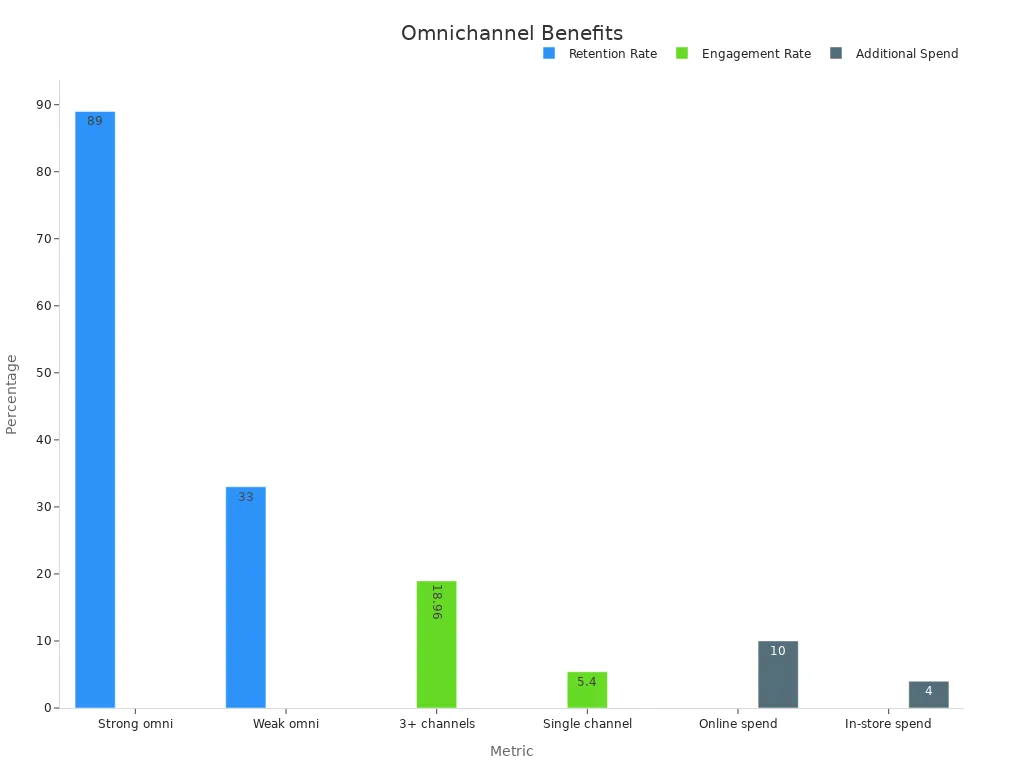
Businesses also benefit from increased productivity and higher conversion rates. For example, Sobot’s platform enables agents to handle more inquiries efficiently, leading to a 30% boost in productivity. Customers enjoy a better experience, which drives loyalty and positive word-of-mouth. In fact, 62% of customers recommend a brand because of great service, and 63% develop strong loyalty due to positive experiences. Omnichannel customer engagement is essential for brands that want to grow and retain their customer base.
Customer Engagement Strategy
Personalization
Personalization stands at the core of any effective customer engagement strategy. Companies that deliver personalized experiences see measurable gains. For example, 82% of consumers willingly share personal data for a more personalized experience, and 70% of shoppers feel more valued when brands tailor their interactions. Businesses that invest in personalization often see a return on investment of at least 400% and a 320% increase in conversion rates from personalized product recommendations. These numbers highlight the power of personalized experiences in driving engagement and loyalty.
Sobot enables brands to create personalized interactions across every channel. Its omnichannel customer engagement platform uses AI and real-time data to segment audiences and deliver relevant messages. With Sobot, companies can automate dynamic content, send targeted campaigns, and provide recommendations based on customer behavior. This approach not only increases satisfaction but also encourages repeat purchases. In fact, 60% of consumers are more likely to become repeat buyers after a personalized experience.
Tip: Personalized emails and calls-to-action can convert up to 42% more visitors into leads, making them essential tools for any customer engagement strategy.
Consistency
Consistency ensures that customers receive the same high-quality service and messaging across all channels. Brands that maintain consistent communication build trust and recognition. Research shows that omnichannel customer engagement with consistent branding strengthens customer relationships and increases conversion rates. Companies that align their brand voice and service standards across platforms see improvements in customer satisfaction scores and revenue growth.
A unified platform like Sobot helps businesses achieve this consistency. By integrating data from every touchpoint, Sobot provides a single view of the customer journey. This allows agents to deliver seamless, connected service whether customers reach out via chat, email, or phone. Consistent experiences also enable real-time campaign adjustments and data-driven decisions, optimizing marketing spend and improving results.
| Benefit of Consistency | Impact |
|---|---|
| Stronger brand recognition | Builds trust and loyalty |
| Higher conversion rates | Multiple interaction points for customers |
| Improved customer experience | Seamless, reliable service |
Key Tactics
Unified Data Hub
A unified data hub forms the backbone of a successful omnichannel strategy. Companies collect data from many sources, such as CRM systems, emails, websites, and social media. By integrating this information, businesses create a single customer profile. This profile helps agents understand each customer's journey and needs.
- 80% of customers expect better experiences based on the data companies collect.
- Real-time synchronization and centralized analytics allow teams to track engagement, conversion, and satisfaction.
- Eliminating data silos ensures every department works with the same information.
Sobot’s omnichannel platform brings all customer data together in one workspace. Agents see a complete history of interactions, which leads to smarter personalization and faster problem-solving. This approach improves the customer experience and builds trust. Companies that invest in unified data hubs also see higher retention rates and better marketing results.
Tip: Building a data-driven culture and investing in integration tools help organizations stay ahead in customer engagement.
Channel Integration
Channel integration connects every touchpoint a customer uses. Customers want to move between channels—like chat, email, and phone—without repeating themselves. Companies that optimize channel integration deliver consistent messaging and seamless service.
- 83% of business leaders say omnichannel approaches match or surpass traditional methods in winning new business.
- 72% of organizations using seven or more channels report growing their market share.
- Cross-channel tracking and coordinated campaigns strengthen brand loyalty.
Sobot’s solution integrates voice, live chat, chatbot, ticketing, and WhatsApp into a single platform. This setup allows agents to manage all conversations in one place. Customers receive the same high-quality service, no matter how they reach out. Channel integration also supports loyalty programs and targeted campaigns, which boost engagement and satisfaction.
Note: Maintaining brand and messaging consistency across channels supports trust and customer retention.
AI and Automation
AI and automation transform how companies engage with customers. These technologies handle routine tasks, provide instant responses, and personalize interactions at scale. AI-powered chatbots answer common questions 24/7, while automation routes inquiries to the right agent.
- AI and automation enhance personalization and operational efficiency.
- Deloitte research shows AI-driven automation improves productivity and customer satisfaction.
- Real-time analytics and AI insights allow for immediate campaign adjustments.
Sobot uses AI to power its chatbots and automate workflows. The platform analyzes customer data to suggest next best actions and deliver proactive support. This reduces agent workload and ensures customers get fast, accurate help. Companies using AI and automation report higher productivity, lower costs, and improved customer experience.
Pro Tip: Use AI to collect feedback and monitor satisfaction. This helps identify friction points and optimize every step of the customer journey.
Omnichannel Contact Center Solutions

Sobot delivers a comprehensive platform that brings together every essential tool for modern customer engagement. The platform includes voice, live chat, AI-powered chatbot, ticketing, and WhatsApp API. These features work together to create a seamless experience for both customers and agents. Businesses using Sobot’s omnichannel call center can manage all customer interactions from one place, reducing complexity and boosting efficiency.
Companies that adopt omnichannel contact center solutions see measurable improvements in service delivery. AI-powered routing matches customers with the right agents, leading to faster resolutions and higher First Call Resolution rates. Real-time analytics help managers monitor performance and adjust staffing, which improves service levels. Cloud-based infrastructure ensures scalability and maintains over 98% uptime, so businesses can rely on consistent operations.
Companies using omnichannel call center technology report a 27% reduction in response times and a 30% increase in agent productivity.
Sobot WhatsApp Integration
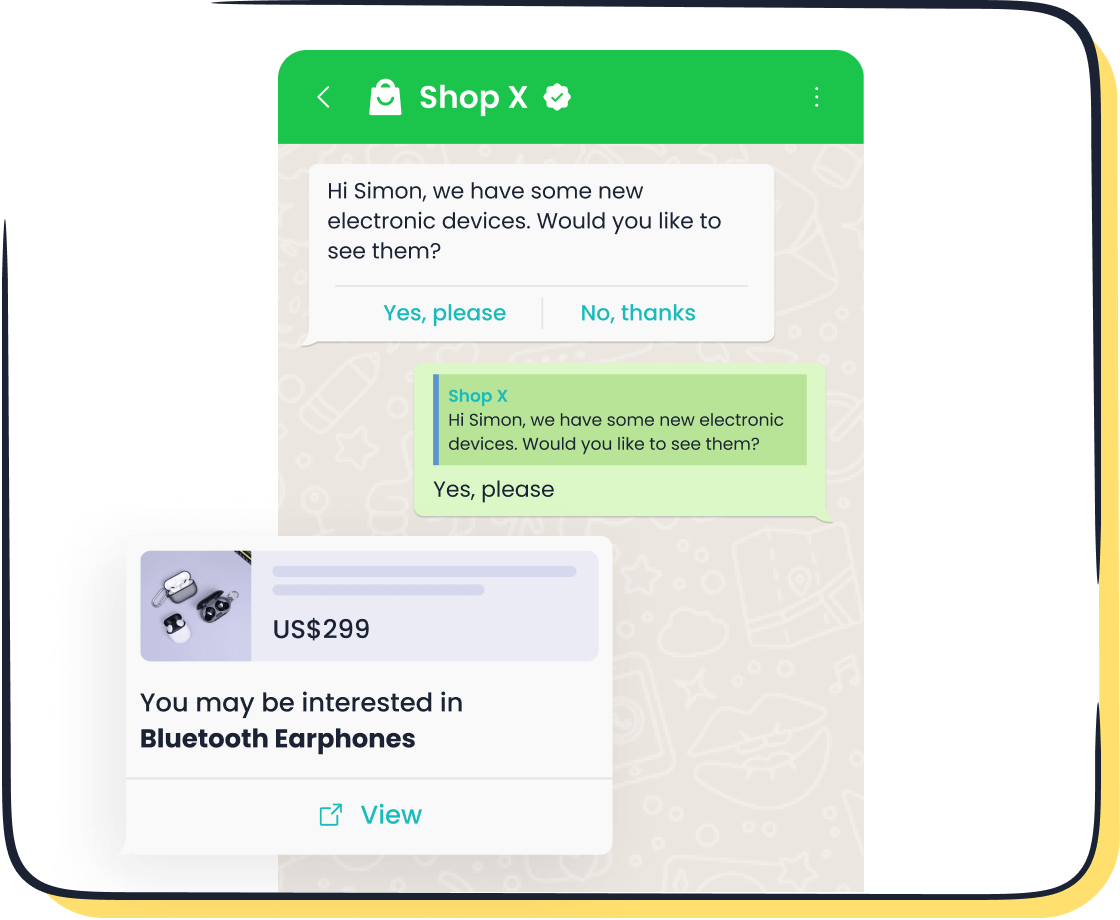
Sobot’s WhatsApp integration stands out as a key feature of its omnichannel contact center solutions. The WhatsApp Business API allows companies to reach customers where they are most active. With official business account certification, businesses gain credibility and trust. The integration supports bulk messaging, 24/7 chatbot responses, and smart chat routing. Agents can handle multiple conversations at once, which increases capacity and reduces wait times.
- 85% of messages sent through WhatsApp are read, making it a powerful channel for marketing and support.
- AI-driven chatbots resolve up to 70% of repetitive queries, freeing agents to focus on complex issues.
- Workflow automation enables businesses to send transactional updates, OTPs, and personalized campaigns at scale.
Sobot’s omnichannel call center ensures that every WhatsApp interaction is tracked and unified with other channels. This approach reduces the need for customers to repeat information and provides a frustration-free experience.
Note: Integrating WhatsApp with other channels helps businesses reduce call volumes and operating costs while improving customer satisfaction.
Unified Workspace
The unified workspace is the heart of Sobot’s omnichannel contact center solutions. Agents access a single dashboard that displays all customer conversations, tickets, and data in real time. This setup eliminates data silos and ensures that every team member works with the same information. Agents can transfer conversations across channels quickly, which speeds up the resolution of complex queries.
- Centralized customer data enables personalized support and faster problem-solving.
- Real-time analytics identify bottlenecks and track key metrics like Average Handling Time and First Call Resolution.
- Seamless handoffs between AI and human agents prevent information loss and reduce customer frustration.
Sobot’s unified workspace also supports predictive workforce management. This feature helps managers optimize staffing, reduce burnout, and improve agent retention. Businesses using omnichannel call center solutions see higher agent utilization rates and lower operational costs.
Real-World Success: Opay’s Transformation
Opay, a leading financial service platform, faced challenges managing high volumes of customer interactions across multiple channels. After implementing Sobot’s omnichannel contact center solutions, Opay unified its social media, email, voice, and WhatsApp communications into a single system. The results were impressive:
- Customer satisfaction increased from 60% to 90%.
- Operational costs dropped by 20%.
- Conversion rates rose by 17%.
- 60% of customers resolved issues independently through self-service options.
- WhatsApp marketing messages achieved an 85% read rate.
Opay’s story shows how omnichannel call center technology can transform customer engagement and drive measurable business growth. By centralizing data and automating routine tasks, Sobot helped Opay deliver faster, more personalized service while reducing costs.
For more details on Opay’s success, visit Sobot’s customer story.
Omnichannel Engagement Strategy
Mapping the Journey
Mapping the customer journey forms the foundation of any successful omnichannel engagement strategy. Companies use journey maps to visualize each phase a customer experiences, from awareness to loyalty. This process helps teams identify key touchpoints, understand customer emotions, and spot pain points. Research shows that 47% of businesses use journey maps to improve their omnichannel engagement strategy, while 75% update these maps regularly to keep up with changing customer behaviors.
A well-designed journey map enables organizations to:
- Improve customer support by analyzing actions and feedback.
- Develop more effective omnichannel marketing strategies.
- Target audiences with personalized messaging, increasing engagement.
- Achieve higher conversion rates and faster sales cycles.
- Tailor omnichannel marketing and support to customer channel preferences.
- Enhance communication through direct feedback.
- Foster better collaboration across departments.
Sobot’s platform supports journey mapping by providing a unified view of customer interactions. Teams can track every step, analyze data, and adjust strategies in real time. This approach ensures that the omnichannel engagement strategy remains relevant and effective as customer needs evolve.
Tip: Regularly update journey maps to reflect new trends and technologies, such as AI-driven personalization and real-time analytics.
Channel Selection
Selecting the right channels is critical for an effective omnichannel engagement strategy. Customers expect brands to meet them where they are, whether on social media, email, live chat, or messaging apps. Companies must analyze customer preferences and behaviors to prioritize channels that drive the most engagement.
Key considerations for channel selection include:
- Understanding which channels customers use at each stage of the journey.
- Leveraging analytics to identify high-performing touchpoints.
- Integrating new technologies, such as WhatsApp or AI chatbots, to enhance cross-touchpoint engagement.
Sobot enables businesses to unify all major channels, including voice, chat, and WhatsApp, into a single workspace. This integration supports seamless omnichannel marketing and ensures consistent service. By choosing the right mix of channels, companies can maximize reach, improve satisfaction, and strengthen their omnichannel engagement strategy.
Effective Omnichannel Strategy
Team Training
Team training stands as a cornerstone of any effective omnichannel strategy. Companies like Cisco have demonstrated that investing in comprehensive training programs leads to measurable improvements. After integrating collaborative platforms and analytics with robust training, Cisco saw a 20% increase in customer satisfaction scores. This success came from empowering employees with both technical and soft skills, enabling them to deliver consistent service across all channels.
Zappos also highlights the value of training. Their rigorous employee development fosters autonomy and a customer-centric culture, resulting in 75% of sales coming from repeat customers. These examples show that well-trained teams can adapt quickly to new technologies and processes. Sobot supports this approach by offering intuitive tools and resources that help agents master omnichannel workflows. When staff understand the technology and the strategy, they provide seamless, high-quality service at every touchpoint.
Tip: Regular upskilling and cross-training ensure teams stay agile and ready for evolving customer needs.
Performance Analytics
Performance analytics play a vital role in executing an effective omnichannel strategy. Businesses must track key metrics such as Customer Satisfaction Scores, Net Promoter Scores (NPS), and Customer Effort Scores (CES) to measure the impact of their engagement efforts. Real-time analytics allow teams to identify issues, optimize processes, and make data-driven decisions.
Continuous monitoring helps companies refine their approach. For example, patient satisfaction surveys and engagement metrics reveal where improvements are needed. Sobot’s platform provides unified analytics dashboards, giving managers a clear view of agent performance and customer interactions across all channels. This transparency supports ongoing refinement and ensures that the effective omnichannel strategy delivers consistent results.
Note: Using analytics tools like those from Sobot enables organizations to spot trends early and respond proactively, maintaining high standards of customer engagement.
Challenges
Data Silos
Data silos create major obstacles for companies aiming to deliver seamless omnichannel customer engagement. When teams store information in separate systems, employees struggle to get a complete view of the customer. This fragmentation leads to slow responses and missed opportunities.
- Nearly two-thirds of customers use three or more touchpoints before making a purchase, and 32% use six or more. This complexity increases the risk of data getting trapped in silos.
- Over half of companies manage customer experience in operational silos, measuring each channel separately. This approach prevents a unified strategy.
- Poor data quality, often caused by silos, blocks 30% of marketers from delivering excellent customer experiences.
- U.S. brands lose an estimated $537 billion each year due to poor experiences linked to siloed data.
- Employees waste more than 20 hours per month on poor collaboration and communication. In North America, this number rises to 28 hours monthly.
Forrester reports that employees lose 2.4 hours per workday searching for information because of data silos. Teams using disconnected tools often send irrelevant campaigns or offer products customers already own. These issues lead to declining customer satisfaction scores and longer time-to-market for new products. Sobot’s unified workspace helps companies break down silos by bringing all customer data into one platform. This approach supports faster responses, better personalization, and reduced churn.
Note: Eliminating data silos not only improves customer experience but also boosts employee productivity and business growth.
Channel Overload
Channel overload happens when companies try to manage too many communication platforms at once. Customers expect to reach brands through their preferred channels, but too many options can overwhelm both customers and agents.
- Different teams often use separate tools, leading to fragmented customer views and inefficient service.
- Employees spend significant time duplicating efforts due to isolated data, wasting valuable resources.
- Misaligned strategies between departments result in missed revenue opportunities and inconsistent messaging.
Channel overload creates bottlenecks and delays in responding to customer inquiries. Customers may receive mixed messages or have to repeat information, which lowers satisfaction. Sobot’s omnichannel solution integrates voice, chat, email, and WhatsApp into a single workspace. This integration streamlines communication, reduces confusion, and supports reduced churn by ensuring every interaction is tracked and managed efficiently.
Tip: Companies should regularly review their channel strategy to focus on the platforms that deliver the most value to customers and the business.
Measurement
KPIs
Key performance indicators (KPIs) help companies track the success of their omnichannel engagement strategies. These metrics provide clear insights into what works and where improvements are needed. Businesses often use a mix of operational and customer-focused KPIs to measure performance across all channels.
| KPI / Metric | Description / Purpose | How it Supports Omnichannel Success |
|---|---|---|
| Customer Satisfaction Score (CSAT) | Measures customer satisfaction with interactions or experiences. | Identifies service gaps, highlights areas for improvement, and guides data-driven decisions to enhance service quality. |
| Net Promoter Score (NPS) | Measures customer loyalty and likelihood to recommend the brand. | Provides insights into customer sentiment, helps address pain points, and fosters long-term loyalty. |
| Customer Retention Rate (CRR) | Percentage of customers retained over time. | Assesses loyalty and effectiveness of retention strategies, enabling targeted improvements to reduce churn. |
| Customer Lifetime Value (CLV) | Forecasts total revenue from a customer over their relationship. | Helps prioritize high-value customers and supports sustainable growth through loyalty programs and personalized service. |
| Conversion Rate | Percentage of visitors who take a desired action (purchase, signup). | Identifies channel effectiveness and areas for marketing optimization to increase sales and engagement. |
| Multi-Channel Engagement Rate | Tracks customer interactions across various channels. | Reveals which channels and content resonate best, enabling integrated campaigns and personalization. |
| Average Order Value (AOV) | Average revenue per order. | Informs pricing, upselling, and promotional strategies to increase revenue per transaction. |
| First Contact Resolution (FCR) | Measures if customer issues are resolved on first contact. | Improves support efficiency and reduces customer effort, enhancing satisfaction and loyalty. |
| Customer Effort Score (CES) | Assesses ease of customer interactions and issue resolution. | Identifies friction points to streamline experience and improve engagement and conversion rates. |
| Average Handle Time (AHT) | Average time to complete a customer transaction or resolve an issue. | Reflects efficiency of support processes, impacting customer satisfaction. |
| Social Media Engagement | Measures likes, shares, comments, and participation on social platforms. | Indicates customer sentiment and engagement, enabling proactive support and community building. |
| Return on Investment (ROI) | Financial performance of omnichannel marketing campaigns. | Assesses marketing spend effectiveness and guides budget allocation for better business outcomes. |
Sobot’s unified analytics dashboard tracks these KPIs in real time. Managers can quickly spot trends, adjust strategies, and ensure every channel delivers value. Monitoring customer lifetime value helps companies focus on high-value relationships and optimize loyalty programs.
Customer Feedback
Customer feedback gives companies direct insight into how customers feel about their experiences. This feedback can come from surveys, social media, or direct messages. Tools like CSAT and NPS surveys help teams understand satisfaction and loyalty. Sobot’s platform collects feedback across all channels, making it easy to spot patterns and act quickly.
- CSAT surveys measure satisfaction after each interaction.
- NPS gauges how likely customers are to recommend the brand.
- Open-ended feedback highlights specific pain points or suggestions.
Companies that listen to feedback can improve service and increase customer lifetime value. For example, analyzing comments from social media or chat helps identify friction points. Quick responses to feedback show customers that their opinions matter, building trust and loyalty.
Tip: Regularly review feedback and KPIs together. This approach ensures that every improvement aligns with customer needs and business goals.
Omnichannel customer engagement drives real business growth. Companies using these tactics see higher sales, better retention, and stronger loyalty. Sobot’s omnichannel solutions help brands unify channels, personalize service, and boost efficiency. Results include:
- 25% increase in online sales and 18% higher retention rates
- 30% rise in customer lifetime value
- 20% more conversions from personalized recommendations
- 25% fewer complaints with AI-powered chatbots
Sobot empowers teams to deliver seamless omnichannel customer engagement. Evaluate your strategy today and explore Sobot’s offerings to start your journey.
FAQ
What is omnichannel customer engagement?
Omnichannel customer engagement connects all customer touchpoints, such as chat, email, and phone, into one seamless experience. Companies like Sobot use unified platforms to help brands deliver consistent service. Research shows 73% of customers use multiple channels during shopping. Source
How does Sobot improve omnichannel customer engagement?
Sobot integrates voice, live chat, chatbot, ticketing, and WhatsApp into a single workspace. This unified approach helps agents respond faster and personalize service. Opay, a Sobot client, increased customer satisfaction from 60% to 90% after adopting Sobot’s omnichannel customer engagement solution.
Why is data integration important for omnichannel customer engagement?
Data integration creates a single customer profile. This helps agents understand each customer’s journey. Sobot’s platform eliminates data silos, leading to 30% higher productivity and better omnichannel customer engagement. Companies with unified data see higher retention and conversion rates.
Can omnichannel customer engagement reduce operational costs?
Yes. Companies using omnichannel customer engagement solutions like Sobot report up to 20% lower operational costs. Automation and AI-powered chatbots handle routine tasks, allowing agents to focus on complex issues. This efficiency leads to fewer complaints and higher customer loyalty.
How can businesses measure the success of omnichannel customer engagement?
Businesses track KPIs such as Customer Satisfaction Score (CSAT), Net Promoter Score (NPS), and First Contact Resolution (FCR). Sobot’s analytics dashboard provides real-time insights. Companies using these metrics see a 25% increase in online sales and 18% higher retention rates.
Tip: Regularly review feedback and analytics to optimize your omnichannel customer engagement strategy.
See Also
A Step-By-Step Approach To Deploy Omnichannel Contact Centers
Comprehensive Overview Of Omnichannel Software For Call Centers
Best Practices For Efficient Management Of Live Chat Agents
